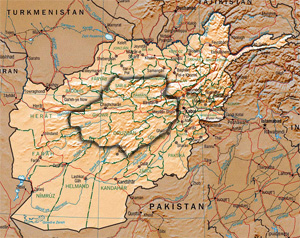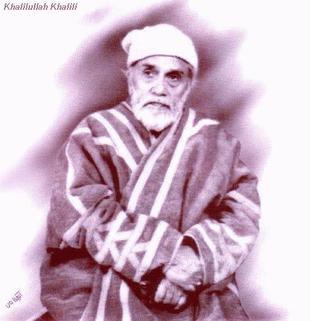Related Research Articles

Afghanistan is a landlocked mountainous country located on the Iranian Plateau, at the crossroads of Central Asia and South Asia. The country is the 40th largest in the world in size. Kabul is the capital and largest city of Afghanistan, located in the Kabul Province. With a location at the intersection of major trade routes, Afghanistan has attracted a succession of invaders since the sixth century BCE.

Kabul is the capital city of Afghanistan. Located in the eastern half of the country, it is also a municipality, forming part of the Kabul Province; it is administratively divided into 22 municipal districts. According to 2023 estimates, the population of Kabul was 4.95 million people. In contemporary times, the city has served as Afghanistan's political, cultural, and economical center, and rapid urbanisation has made Kabul the 75th-largest city in the world and the country's primate city.

The Hindu Kush is an 800-kilometre-long (500 mi) mountain range on the Iranian Plateau in Central and South Asia to the west of the Himalayas. It stretches from central and eastern Afghanistan into northwestern Pakistan and far southeastern Tajikistan. The range forms the western section of the Hindu Kush Himalayan Region (HKH); to the north, near its northeastern end, the Hindu Kush buttresses the Pamir Mountains near the point where the borders of China, Pakistan and Afghanistan meet, after which it runs southwest through Pakistan and into Afghanistan near their border.

The Helmand River is the longest river in Afghanistan and the primary watershed for the endorheic Sistan Basin. It originates in the Sanglakh Range of the Hindu Kush mountains in the northeastern part of Maidan Wardak Province, where it is separated from the watershed of the Kabul River by the Unai Pass. The Helmand feeds into the Hamun Lake on the border of Afghanistan and Iran.

Hazaristan, also known as Hazarajat is a mostly mountainous region in the central highlands of Afghanistan, among the Kuh-e Baba mountains in the western extremities of the Hindu Kush. It is the homeland of the Hazara people who make up the majority of its population. Hazarajat denotes an ethnic and religious zone.

Maidan Wardak or Wardak, also called Wardag is one of the 34 provinces of Afghanistan, located in the central region of Afghanistan. It is divided into eight districts and has a population of approximately 500,000. The capital of the province is Maidan Shar, while the most populous district in the province is Saydabad District. Wardak is known for one of its famous high peak mountain known as.

The Kabul River, the classical Cophen, is a river that emerges in the Sanglakh Range of the Hindu Kush mountains in the northeastern part of Maidan Wardak Province, Afghanistan. It is separated from the watershed of the Helmand River by the Unai Pass. The Kabul River is a tributary of the Indus River, flowing into it near Attock, Pakistan. The Kabul is the main river in eastern Afghanistan and in the Khyber Pakhtunkhwa province of Pakistan.

Unaí is a municipality in the Northern Region of Minas Gerais, in the Brazilian state of Minas Gerais, in the Southeast Region of Brazil. It is located 590 km from the capital of Minas Gerais and 164 km from the federal capital. Unaí is the main municipality of its micro-region of the same name and, together with Paracatu, the most important city of the said mesoregion of Minas Gerais. Due to its geopolitical location, because it is geographically and politically linked to Brasilia and politically to Belo Horizonte, the municipality has a strong economic dynamism for a municipality that still carries the typically mineiro custom.
The Logar River is a river of Afghanistan. It gives the name to the Logar Valley and Logar Province. In Maidan Wardak Province where the river originates, it is called Chak River. The Chaki Wardak Dam is built on the river in Chaki Wardak District, Maidan Wardak Province.

The Hajigak Pass is a mountain pass of Afghanistan. It is situated at a height of 3,700 metres (12,100 ft) above sea-level in the northern part of Maidan Wardak province, connecting it with Bamyan province to the northwest. It is one of the two main routes from Kabul to Bamyan in Hazarajat, leading across the Koh-i-Baba range.

Khalilullah Khalili was Afghanistan's foremost 20th century poet as well as a noted historian, university professor, diplomat and royal confidant. He was the last of the great classical Persian poets and among the first to introduce modern Persian poetry and Nimai style to Afghanistan. He had also expertise in Khorasani style and was a follower of Farrukhi Sistani. Almost alone among Afghanistan's poets, he enjoyed a following in Iran where his selected poems have been published. His works have been praised by renowned Iranian literary figures and intellectuals. Many see him as the greatest contemporary poet of the Persian language in Afghanistan. He is also known for his major work "Hero of Khorasan", a controversial biography of Habībullāh Kalakānī, Emir of Afghanistan in 1929.
Jalrez is a district in the west of Maidan Shar, Maidan Wardak Province, Afghanistan. The main town lies at Jalrez, which is 62.9 kilometres (39.1 mi) southwest of the centre of Kabul via the main Kabul-Behsud Highway. The district is a major producer of potatoes.

Shibar Pass in Afghanistan is situated at a height of 3,000 metres (9,800 ft) above sea-level, connecting Parwan Province with Bamyan Province. It is the longer of the two main routes from Kabul to Bamiyan. The journey is approximately 6 and half hours long covering around 237 km (147 mi). It was originally designed and built by Ahmad Shah Shairzay and a German engineer between 1933 and 1938. It is noted to be an important mountain pass of the country.

Unai Emery Etxegoien is a Spanish football manager and former player who is the manager of the Premier League club Aston Villa.

Bonfinópolis de Minas is a municipality in the north of the Brazilian state of Minas Gerais. The population of the municipality in 2020 by the Brazilian Institute of Geography and Statistics (IBGE) is 5,444 inhabitants in a total area of 1,778 km2. The elevation of the municipal seat is 651. It became a city in 1962.

Unai Simón Mendibil is a Spanish footballer who plays as a goalkeeper for La Liga club Athletic Bilbao and the Spain national team.
Cave of Gentio is a parietal art-bearing archaeological site situated about 30 km from Unaí, Minas Gerais, 180 km away from the Federal District.
The Subdistricts of Afghanistan are the third-level administrative units of Afghanistan, subdivisions of the districts. They are known as "Alaqadari" and are the smallest administrative divisions. Each alaqadari is headed by an "alaqadar", appointed by the government in Kabul or a provincial governor.

The Unai Pass or Onai Pass is a mountain pass on the western side of the Paghman Mountains in Jalrez District, Maidan Wardak Province, Afghanistan. It is of strategical importance due to its geographical location to the southwest of Kabul. The Sarchashma River flows through the pass, which is the upstream part of the Kabul River. The Maidan River, a tributary of the Kabul/Sarchashma rises at the pass at an altitude of about 3,300 metres (10,800 ft).
The Battle Of Unai Pass took place at Unai Pass in 1929, during the Afghan Civil War when the Saqqawist army was trying to cross the Unai Pass to subjugate the Hazaras of Jang Kala. The battle was from June 28 to July 10, and several raids and offensives after that until the fall of the Saqqawists. The Hazara volunteers from Jang Kala under the leadership of Fateh Mohammad Khan defended their positions and launched a few attacks on the Saqqawists in Jalrez and the surrounding areas. The hordes of the Saqqawist army were successfully repelled by the Hazaras and the Saqqawist army retreated after many of them got killed or got captured. This was one of the battles recorded between the Hazaras and the Saqqawists when trying to enter Hazarajat
References
- ↑ Chisholm, Hugh (1911). The Encyclopædia Britannica: Italy-Kyshtym. At the University Press. p. 625.
- ↑ Military Report on Afghanistan. Division of the Chief of the Staff. 1906. p. 7.